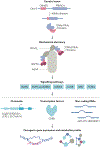A framework for fibrolamellar carcinoma research and clinical trials
- PMID: 35190728
- PMCID: PMC9516439
- DOI: 10.1038/s41575-022-00580-3
A framework for fibrolamellar carcinoma research and clinical trials
Abstract
Fibrolamellar carcinoma (FLC), a rare, lethal hepatic cancer, occurs primarily in adolescents and young adults. Unlike hepatocellular carcinoma, FLC has no known association with viral, metabolic or chemical agents that cause cirrhosis. Currently, surgical resection is the only treatment demonstrated to achieve cure, and no standard of care exists for systemic therapy. Progress in FLC research illuminates a transition from an obscure cancer to one for which an interactive community seems poised to uncover fundamental mechanisms and initiate translation towards novel therapies. In this Roadmap, we review advances since the seminal discovery in 2014 that nearly all FLC tumours express a signature oncogene (DNAJB1-PRKACA) encoding a fusion protein (DNAJ-PKAc) in which the J-domain of a heat shock protein 40 (HSP40) co-chaperone replaces an amino-terminal segment of the catalytic subunit of the cyclic AMP-dependent protein kinase (PKA). Important gains include increased understanding of oncogenic pathways driven by DNAJ-PKAc; identification of potential therapeutic targets; development of research models; elucidation of immune mechanisms with potential for the development of immunotherapies; and completion of the first multicentre clinical trials of targeted therapy for FLC. In each of these key areas we propose a Roadmap for future progress.
© 2022. Springer Nature Limited.
Figures


References
-
- Edmondson HA Differential diagnosis of tumors and tumor-like lesions of liver in infancy and childhood. AMA J. Dis. Child 91, 168–186 (1956). - PubMed
-
- Berman MM, Libbey NP & Foster JH Hepatocellular carcinoma. Polygonal cell type with fibrous stroma–an atypical variant with a favorable prognosis. Cancer 46, 1448–1455 (1980). - PubMed
-
- Craig JR, Peters RL, Edmondson HA & Omata M Fibrolamellar carcinoma of the liver: a tumor of adolescents and young adults with distinctive clinico-pathologic features. Cancer 46, 372–379 (1980). - PubMed
-
This paper names fibrolamellar carcinoma and describes the tumour as a distinct entity.
-
- Farhi DC, Shikes RH & Silverberg SG Ultrastructure of fibrolamellar oncocytic hepatoma. Cancer 50, 702–709 (1982). - PubMed
-
- O’Neill AF et al. Fibrolamellar carcinoma: an entity all its own. Curr. Probl. Cancer 45, 100770 (2021). - PubMed
-
A current review that emphasizes clinical aspects of FLC.
Publication types
MeSH terms
Substances
Supplementary concepts
Grants and funding
LinkOut - more resources
Full Text Sources
Medical
Miscellaneous

